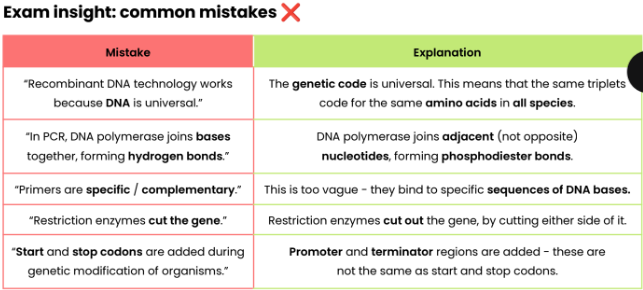8.4 Gene technologies. 8.4.1 Recombinant DNA technology
1/21
There's no tags or description
Looks like no tags are added yet.
Name | Mastery | Learn | Test | Matching | Spaced |
|---|
No study sessions yet.
22 Terms
What is recombinant DNA technology?
Transfer of DNA fragments from one organism or species, to another
Explain why transferred DNA can be translated within cells of recipient
(transgenic) organisms
Genetic code is universal
2. Transcription and translation mechanisms are universal
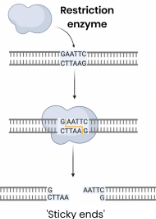
Describe how DNA fragments can be produced
using restriction enzymes
1. Restriction enzymes cut DNA at specific base ‘recognition
sequences’ either side of the desired gene
○ Shape of recognition site complementary to active site
2. Many cut in a staggered fashion forming ‘sticky ends’
(single stranded overhang)
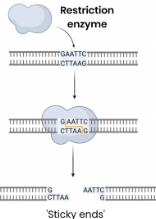
Describe how DNA fragments can be produced from mRNA
1. Isolate mRNA from a cell that readily synthesises the protein coded for by the desired gene
2. Mix mRNA with DNA nucleotides and reverse transcriptase → reverse transcriptase uses
mRNA as a template to synthesise a single strand of complementary DNA (cDNA)
3. DNA polymerase can form a second strand of DNA using cDNA as a template
Suggest two advantages of obtaining genes from mRNA rather than directly
from the DNA removed from cells
● Much more mRNA in cells making the protein than DNA → easily extracted
● In mRNA, introns have been removed by splicing (in eukaryotes) whereas DNA contains introns
○ So can be transcribed & translated by prokaryotes who can’t remove introns by splicing
Describe how fragments of DNA can be produced using a gene machine
● Synthesises fragments of DNA quickly & accurately from scratch qwithout need for a DNA template
○ Amino acid sequence of protein determined, allowing base sequence to be established
● These do not contain introns so can be transcribed & translated by prokaryotes
Name an in vitro and in vivo technique used to amplify DNA fragments
● In vitro (outside a living organism) - polymerase chain reaction (PCR)
● In vivo (inside a living organism) - culturing transformed host cells eg. bacteria
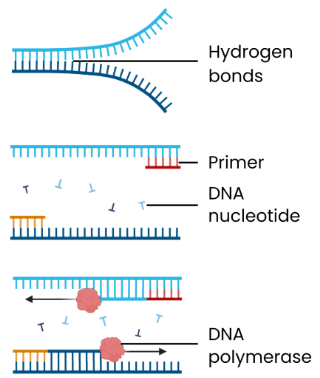
Explain how DNA fragments can be amplified by PCR
Reaction mixture: DNA fragment, DNA polymerase (eg. taq polymerase), primers and DNA nucleotides
This cycle is repeated - in every cycle, the amount of DNA doubles causing an exponential increase (2^n)
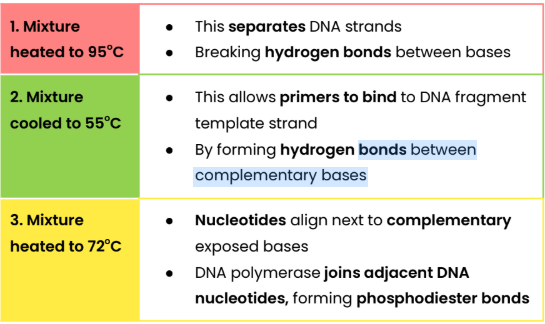
Explain the role of primers in PCR
● Primers are short, single stranded DNA fragments
● Complementary to DNA base sequence at edges of region to be copied / start of desired gene
● Allowing DNA polymerase to bind to start synthesis (can only add nucleotides onto pre-existing 3’ end)
● Two different primers (forward and reverse) are required (as base sequences at ends are different)
Suggest one reason why DNA replication eventually stops in PCR
There are a limited number of primers and nucleotides which are eventually used up
Summarise the steps involved in amplifying DNA fragments in vivo
1. Add promoter and terminator regions to DNA fragments
2. Insert DNA fragments & marker genes into vectors (eg. plasmids) using restriction enzymes and ligases
3. Transform host cells (eg. bacteria) by inserting these vectors
4. Detect genetically modified (GM) / transformed cells / organisms by identifying those containing the marker gene (eg. that codes for a fluorescent protein)
5. Culture these transformed host cells, allowing them to divide and form clones
Following this, DNA can be extracted from the host cells if needed or the host cells can produce a protein coded for by a gene in the DNA fragment
Explain why promoter and terminator regions are added to DNA fragments that are used to genetically modify organisms
Promoter regions
● Allow transcription to start by allowing RNA polymerase to bind to DNA
● Can be selected to ensure gene expression happens only in specific cell types
○ Eg. in gland cells of a mammal so the protein can be easily harvested
Terminator regions
● Ensure transcription stops at the end of a gene, by stopping RNA polymerase

What are the role of vectors in recombinant DNA technology?
To transfer DNA into host cells / organisms eg. plasmids or viruses (bacteriophage)
Explain the role of enzymes in inserting DNA fragments into vectors
1. Restriction endonucleases / enzymes cut vector DNA
○ Same enzyme used that cut the gene out so vector DNA & fragments
have ‘sticky ends’ that can join by complementary base pairing
2. DNA ligase joins DNA fragment to vector DNA
○ Forming phosphodiester bonds between adjacent nucleotides
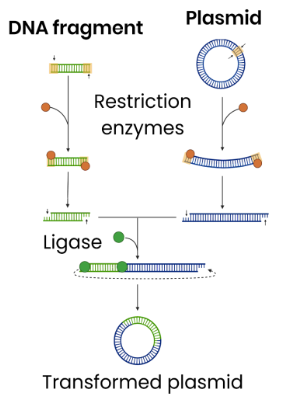
Describe how host cells are transformed using vectors
● Plasmids enter cells (eg. following heat shock in a calcium ion solution)
● Viruses inject their DNA into cells which is then integrated into host DNA
Explain why marker genes are inserted into vectors
● To allow detection of genetically modified / transgenic cells / organisms
○ If marker gene codes for antibiotic resistance, cells that survive antibiotic exposure = transformed
○ If marker gene codes for fluorescent proteins, cells that fluoresce under UV light = transformed
● As not all cells / organisms will take up the vector and be transformed
Suggest how recombinant DNA technology can be useful
Medicine
● GM bacteria produce human proteins (eg. insulin for type 1 diabetes) → more ethically
acceptable than using animal proteins and less likely to cause allergic reactions
● GM animals / plants produce pharmaceuticals (‘pharming’) → cheaper
● Gene therapy (see below)
Agriculture
● GM crops resistant to herbicides → only weeds killed when crop sprayed with herbicide
● GM crops resistant to insect attack → reduce use of insecticide
● GM crops with added nutritional value (eg. Golden rice has a precursor of vitamin A)
● GM animals with increased growth hormone production (eg. Salmon)
Industry
● GM bacteria produce enzymes used in industrial processes and food production
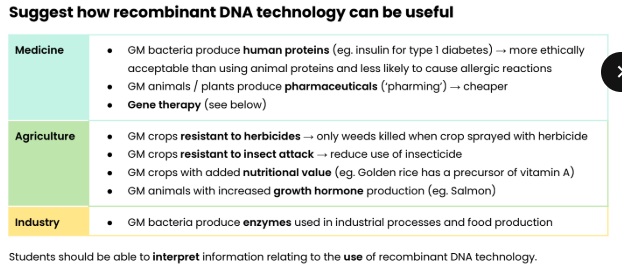
Describe gene therapy
● Introduction of new DNA into cells, often containing healthy / functional alleles
● To overcome effect of faulty / non-functional alleles in people with genetic disorders eg. cystic fibrosis
Note - if body cells are altered, changes are not heritable. Gene therapy in gametes is currently illegal.
Students should be able to relate recombinant DNA technology to gene therapy.
Suggest some issues associated with gene therapy
● Effect is short lived as modified cells (eg. T cells) have a limited lifespan → requires regular treatment
● Immune response against genetically modified cells or viruses due to recognition of antigens
● Long term effect not known - side effects eg. could cause cancer
○ DNA may be inserted into other genes, disrupting them → interfering with gene expression
Suggest why humanitarians might support recombinant DNA technology
● GM crops increase yields → increased global food production → reduced risk of famine / malnutrition
● Gene therapy has potential to cure many genetic disorders
● ‘Pharming’ makes medicines available to more people as medicines cheaper
Suggest why environmentalists and anti-globalisation activists might oppose recombinant DNA technology
● Recombinant DNA may be transferred to other plants → potential herbicide resistant ‘superweeds’
● Potential effects on food webs eg. affect wild insects → reduce biodiversity
● Large biotech companies may control the technology and own patents
Students should be able to evaluate the ethical, financial & social issues associated with the use and ownership of recombinant DNA technology in agriculture, in industry & in medicine AND balance the humanitarian aspects of recombinant DNA technology with the opposition from environmentalists & anti-globalisation activists.
